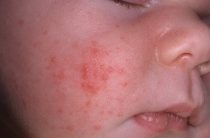Literally everyone is familiar with the term “allergy”, but not everyone knows about the mechanisms of this disease. This disorder is formed as a result of high selective sensitivity to certain substances, which are called allergens. It occurs when the body repeatedly interacts with this substance. The first interaction with the allergen occurs without any tangible changes, at this moment the immune system only triggers the mechanisms of memory and recognition.
Recognizing an allergy is not so difficult: a runny nose, rashes, itchy skin, watery eyes and other symptoms of this disease are very common in the modern world. Symptoms can vary significantly from patient to patient, but still retains the outlines characteristic of this disease.
Allergy provocateurs
Factors that provoke a sensitive reaction of the body are called allergens. There are a huge number of them. But at the same time, there are those that most often cause allergies:
- House dust. And to be completely accurate, then small bugs that live on its surface. They are so small that they are even invisible to the human eye.
- Plant pollen. This type of allergy manifests itself when plant pollen appears in the air.
- Animal hair that contains their waste products, which are allergens.
- Bird feathers (see animal hair).
- Mold spores.
- Medical facilities.
- Means of cosmetics and perfumery.
- Food.
- The poison of stinging insects. The poison of bees and wasps is especially dangerous, since an allergy to it is very difficult to tolerate.
Why does the body use such methods of responding to these substances? The fact is that with the help of allergic symptoms, the body is cleared of the presence of the allergen, and also signals that this substance is dangerous. In general, these reactions occur as a result of a malfunction in the normal response processes of the immune system, which ceases to recognize neutral or friendly substances adequately.
Allergy and baby
Childhood illness is a real nightmare for any mother.
Meanwhile, in infants, allergic reactions occur very often. Therefore, every mother should be familiar with the symptoms of this disorder, so as not to confuse them with other diseases and take measures to limit the interaction of the baby with the allergen. A rash on the skin is one of those allergy symptoms in a baby that is encountered more often than others, and meanwhile, delicate baby skin can become covered with rashes, not only under the influence of an allergen. It can be, for example, milia - the appearance of a whitish acne in a baby, which is not dangerous and is eliminated by the usual children's hygiene procedures. Excessively warm clothes can provoke the appearance of prickly heat, which is caused by moisture emanating from the body of the baby when overheated. To eliminate these rashes, just take a bath and dress the baby as appropriate at a given temperature.
Causes of childhood allergies
Often, the development of an allergic disease is preceded by a number of factors. This may be intestinal dysbacteriosis, which often appears at an early age, the use of drugs containing antibiotics, improper feeding, early termination of breastfeeding. The role of hereditary factors is also great, especially in cases where the mother herself is prone to allergic diseases.
Babies are prone to food allergies because their digestive system is still in its infancy and may have difficulty digesting food. Artificial food mixtures, for the baby, often cause allergic reactions. The body, at this age, can reject the proteins that make up cow's milk.
Fruit puree and vegetable puree, often used for feeding, should be introduced into the diet with more care than is usually the case. Often, food intolerance can manifest itself in a baby to fruits and vegetables that have bright colors. Be careful with tomato puree, apricot, carrot, beet, berry. It is advisable to start dating the baby, with these products, with small portions, in order to prevent a strong allergic reaction. Keep in mind that allergy manifestations can occur even after a few days after consuming a product containing an allergen. Therefore, when introducing a new product, it is desirable to pause for several days until the next application.
On the part of the mother, in addition to heredity, there are a number of factors that provoke the development of allergies:
- unfavorable course of pregnancy
- infectious diseases during pregnancy
- violation of the diet, while breastfeeding
- gastrointestinal disorders
- maternal stress during pregnancy
Vaccination is also a common cause of allergies. In this case, it can occur both for the drug itself and for the excipients used for this drug. Sensitive baby skin may react with manifestations of sensitivity to products used for domestic purposes. Especially often, the culprit of a skin allergy in a baby is soap with antibacterial components.
How to recognize an allergy in a child
Recognizing the presence of an allergic disease in children is not so difficult. In the first half of the year, in children, in case of food intolerance, formations appear, localized on the cheeks, in the form of reddish swelling. After a while, a dense transparent or yellowish moisture appears on them, which transforms into a yellowish crust. Allergic manifestations can also be expressed by local overdrying and peeling of the skin.
The disease can also appear with the formation of diaper rash, against which conventional methods do not help, to eliminate. The gastrointestinal tract can also be sensitive to allergen ingestion. In this case, colic may appear, stool worsens, belching becomes more frequent.
Urticaria in a child
A common allergic symptom in children is hives, which is caused by food intolerance or insect bites. In children who grow up on breastfeeding, hives may occur as a result of the fact that the mother made mistakes in her diet when breastfeeding. At the stage of breastfeeding, the mother is not allowed to eat the following products: seafood, citrus fruits, red berries and fruits, marinades, smoked meats, sausages, honey, nuts. These products are included in the diet in minimal quantities, not earlier than the time of introduction that is relevant for them.
Recognizing the symptoms of hives in children is not a difficult task. Urticaria is manifested by the formation of round swelling, small height, red or pink hue. They may vary in size, adjacent formations tend to join with each other. Rashes with urticaria can also be located in the region of the larynx, which causes bouts of coughing and perspiration. Urticaria causes considerable inconvenience to the child, as a result of which he becomes whiny and irritable.
Children's dermatitis
Dermatitis in a child is an inflammatory process that occurs on the skin surface. In children, in the first year of life, to meet the symptoms of dermatitis is far from uncommon. This is due to the fact that in the first year of life the most intensive formation of various organs and systems occurs. Immunity, in the future, learns to adequately respond to substances coming from outside. But until this happens, children are vulnerable to allergic manifestations.
Often dermatitis develops in case of allergic diseases in the mother or father. But it is not uncommon for it to form on its own. without hereditary transmission.
Children at risk:
- in the presence of allergic diseases in parents or close relatives
- if the mother, being in a state of pregnancy, became infected with viral infections
- viral diseases in babies, at an early age
- severe pregnancy
- with untimely use of natural products in the diet
- children growing up in an unfavorable environmental situation
Atopic dermatitis
With this type of dermatitis, skin inflammations appear in children. it can be recognized by the characteristic dermatological changes in the skin: they turn red, swell, small plaques filled with liquid appear. The face and hands are the first to suffer from atopic dermatitis. Dermatitis often manifests itself in children with a hereditary tendency to this disease.
Dermatitis can manifest itself in several cases, its causes are food, contact allergens and drugs. The results of blood tests fix a high level of general and special antibodies during an exacerbation of an allergic reaction. Symptoms of atopic dermatitis can be triggered by a gastrointestinal disorder called dysbacteriosis. In this case, there is a violation in the work of the microflora of the child, which leads to the fact that the proportion between beneficial and harmful bacteria is violated, towards the latter.
contact dermatitis
This type of dermatitis occurs when the child's skin is in direct contact with provoking substances. These can be cosmetics, household chemicals, pet hair, clothing fabrics. With this type of dermatitis, the rash is localized in those places that have close contact with the allergen.
Contact dermatitis, in case of failure to provide timely medical treatment, may acquire the course of a chronic disease.
Means to combat dermatitis
In order to overcome dermatitis, first of all, it is necessary to normalize nutrition. Allergens should be completely eliminated from the baby's diet, while replacing it with a product that is identical in nutritional quality. If the baby stops using allergens, this will lead to a gradual elimination of symptoms, even without the introduction of drugs. Children who are sick with dermatitis should also not eat fried foods, whole milk, cocoa bean products, chicken eggs, smoked foods, bee products. The use of salt, with dermatitis, should be minimized.
Food should be of natural origin, without the use of synthetic additives. Pesticide fertilizers, which are often used when growing vegetables, negatively affect allergy symptoms. Acceptable cooking methods are stewing, boiling and steaming.
Helpful Hints:
- The balance of the intestinal flora can be improved through the use of prebiotic and probiotic products.
- If possible, use hypoallergenic and natural hygiene products to avoid irritation of the child's sensitive skin;
- Keep an eye on the composition of the laundry detergents that you use for your baby's clothes, they should not include phosphate components, fragrances and chlorine. These substances often cause both allergic reactions and provoke additional skin irritation.
- Breast milk has a beneficial effect on the course of the disease, and compresses from it will soothe inflammatory processes on the skin;
- Children's clothing should be free of wool and synthetic fibers that can cause skin irritation.
- Use products like Bepanthen to hydrate your skin and help heal wounds caused by allergies.
Allergy to gluten in a child
Gluten is a specific sticky plant protein that forms the basis of plants such as rye, oats, wheat and barley. There are two forms of disease associated with gluten rejection in children: gluten intolerance and gluten sensitization. With intolerance, there is no immune component, which is typical for allergic reactions.
How to recognize a gluten allergy
An allergy to gluten in a child can appear only after the introduction of natural products into the diet. Gluten is a purely vegetable protein and cannot be found in breast milk. In the first years of life, the microflora that is involved in the digestion of proteins is only being formed. For this reason, such a complex protein as gluten does not enter the bloodstream in the form of amino acids, but in its entirety. Antibodies have a high affinity for proteins, since their presence in the body may indicate the presence of a parasitic invasion. These factors directly form an allergy to gluten in a baby.
You can recognize it by the following features:
- the appearance of skin rashes of a dermatological nature or symptoms of urticaria
- worsening of the stool, in the form of diarrhea
- increased gas formation
- changes in the character of the child, he constantly cries and is naughty
- weight loss, weakness, pale skin
Gluten in this case disrupts the digestive process. This has an extremely negative impact on the health of the child, since digestion is responsible for the intake of micro and macronutrients in the child's body.
Proteins are building blocks for our body, carbohydrates are necessary for the formation and functioning of the brain, as energy raw materials, fats are part of cell membranes and are also sources of energy, vitamins and minerals take part in many biochemical reactions. During the developmental stage, it is very important that all these nutrients are supplied to the child's body, in sufficient quantities.
The correct introduction of natural products starts from the age of 6 months, when breastfeeding. If the baby was forced to eat artificial mixtures, then acquaintance with natural products can be started a month earlier. Fruit and vegetable juices, as well as purees, are optimal to start feeding. But they must also be administered carefully. Vegetables and fruits such as carrots, strawberries, pumpkins, tomatoes can cause allergic reactions, so you need to be careful with them.
Rice and buckwheat are optimal cereals for a baby. They are rich in vitamins and minerals and are gluten free. They can be introduced into the diet from the age of 8 months.
If your baby, with the help of special tests, doctors recognized an allergy, then a number of measures must be taken to help avoid allergic manifestations. You need to start with the exclusion of oatmeal, semolina, wheat groats, as well as pearl barley. Corn, potatoes, legumes, rice, and buckwheat are gluten-free foods. They should replace gluten cereals in the baby's diet.
Flour products that are used using wheat flour must be discarded. Meat and dairy products are an excellent supplier of amino acids (essential and non-essential types), which the body badly needs at the formation stage.
Look carefully at the composition of the products. Many prepared foods contain gluten, which is used as a thickening agent. Especially often it is used in yoghurts, ryazhenka. Therefore, it is necessary to carefully study the composition of the products before buying.
We advise you to read:















